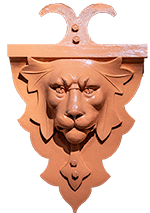Progress Report - January 2023
The Heyford building site could be compared to a swan right now. Everything you can see is neat and tidy – just a neat, flat, rectangular concrete surface. Like the graceful swan, the real story is beneath the surface, where we have hidden all the reinforcing with concrete.
We’ve described the work involved in connecting up the reinforcing bar (rebar) previously, but if it wasn’t for the pictures, nobody would ever know what we did – hopefully it will remain hidden for hundreds of years!
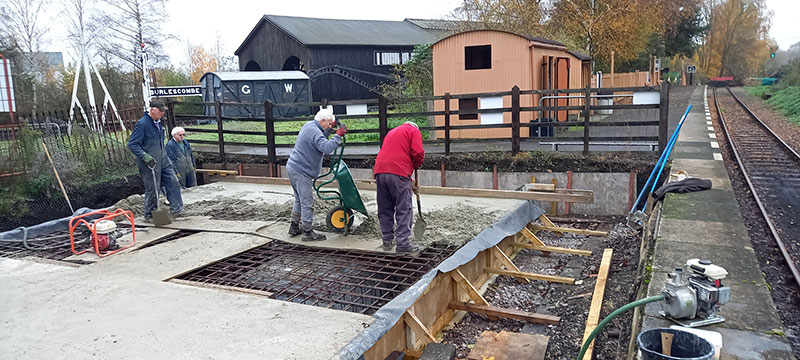
Just before any concrete was poured, we had our first inspection from the local authority Building Control officer, who expressed satisfaction with all the rebar, just before the last pieces were wired together. That wiring did seem to go on for ever. We tried to calculate the number of pieces of steel or the number of wired connections, but we need far more fingers than the team possesses – let’s just agree that there really are thousands of connections. There was one last job before each pour to remove any leaves or other debris out of the hole and pump out any rainwater – reaching in over all the rebar with all its sharp wires to remove wet leaves at full reach is yet another of those jobs that isn’t much fun, but is very necessary.
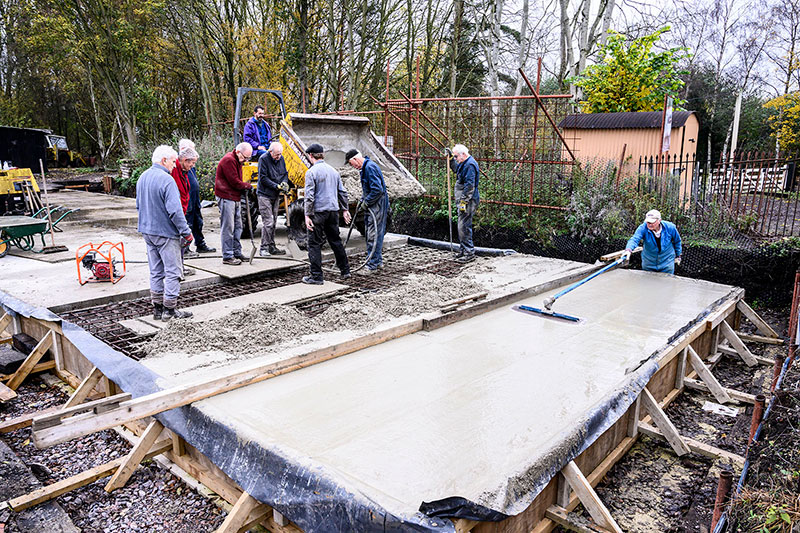
We scheduled a plan for pouring the concrete in four sections – there was some suggestion we might do it in three, but several of us were quite exhausted after each pour-day, so four was definitely the right decision. The timetable slipped a couple of times whilst we ensured we had the right amount of labour and all the materials and plant we needed, but the days of the pours all went exactly as planned. Everybody had a specific job to do; measuring the cement, hauling the aggregate to feed the mixer, operating the mixer, driving the dumper trucks; shovelling the concrete out of the dumper (3 people plus reserves) wheelbarrow pushers (a full barrow of concrete is very difficult to move and easy to tip on its side – but we didn’t tip any over!), operating the air poker, two people to operate the screed bar and someone to polish the surface – real team work from a lot of people, most of whom were relatively inexperienced at such tasks.
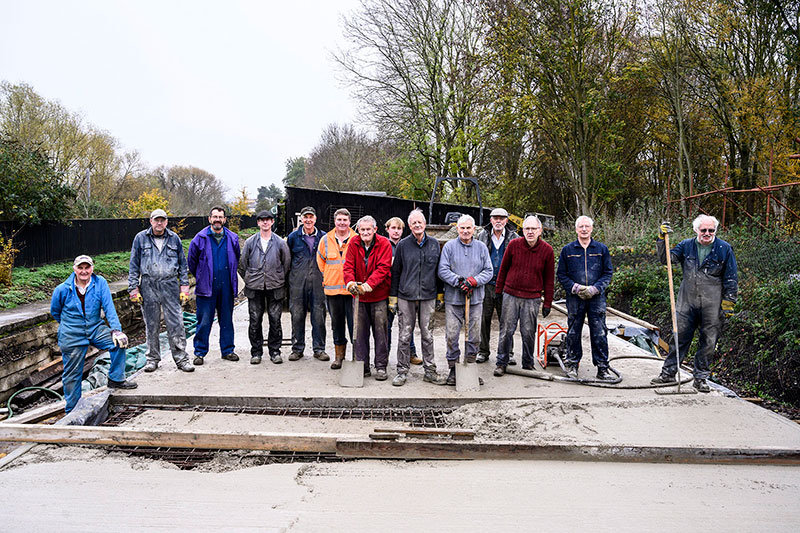
The combined Tuesday and Thursday gangs near completion of the fourth and final pour; (L to R) Alan Wiffen, Mick Howse, Tim Part, Mark Werrell, Dave Godfrey, Chris Adamson, Steve Ryder, Harry Jones, Ian Kinloch, Alan Price, Richard Beacham, Tim Masson, Lionel Robbins, Robert Heron
The photo here is of the team that were involved in the last pour, just before we were finished – you can see on our faces the mixture of satisfaction of a job done well and tiredness after a challenging day. For the record the final foundation pour was completed on Tuesday 29th November.
In addition to the foundation work we dug and later re-filled a trench to get a water supply to the site, connecting up with the mains at the front of the carriage shed. This has made tea-making a lot easier, so we are hoping to have more tea-breaks! However we will need to extend the pipe to the building itself and beyond to the proposed broad gauge water tower to complete this exercise.
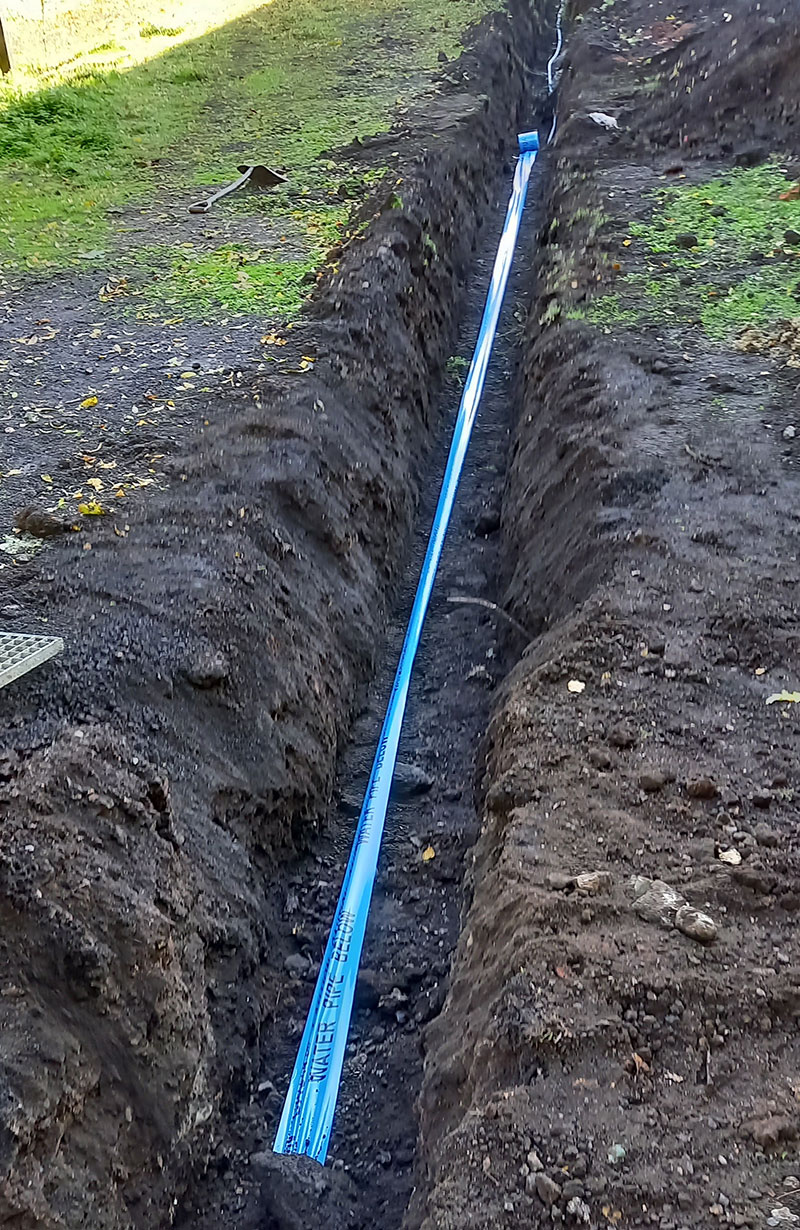
So, what is next?
Firstly, there is the matter of governance and funding. When we started this project, we were given permission by the GWS Board only to build the foundations, not the whole building. This was partly because funding was not assured, but that position has improved. The Board certainly wanted the option of opening the platform to hold a 3-coach train and allow passengers to see their engine properly. We haven’t actually achieved that yet, but will do in a few months.
Despite costs rising post covid and in our strange inflationary times, the Board has recognised that the team has momentum, and, of course, we all want the building complete, so at a recent Board Meeting it was agreed that we can proceed, albeit with the usual caution about affordability. As a team we are delighted that they appreciate our efforts.
It’s a good opportunity to mention that there are usually 6 to 8 volunteers working on this project on site every Thursday, often more. We are now one of the largest regular teams of volunteers at the Railway Centre. And two or three of us do additional work at home – architecture and preparing and planning.
We have been informed of a bequest to the Society, made in the hope that it will be used to pay for the plinth stones, we are grateful to the donor’s family for this and have just ordered the stones. The original plinth stones were left behind at Heyford when the building was dismantled by the GWS. Some were a bit battered, but the main reason was that they were simply too heavy to move as they were so large. We considered making replacements out of blockwork and rendering them, or casting them in concrete to look like stone, but with the bequest we have been able to buy new stone. Whilst they will look much like the originals, they will not be as high – they were buried as foundations, but the same amount will be visible – or as deep – we only need them to form the outside of the cavity wall – so there will be blocks below and on the inside. They are still very expensive! We expect them to be delivered in April. We have just started marking the setting out positions for these stones.
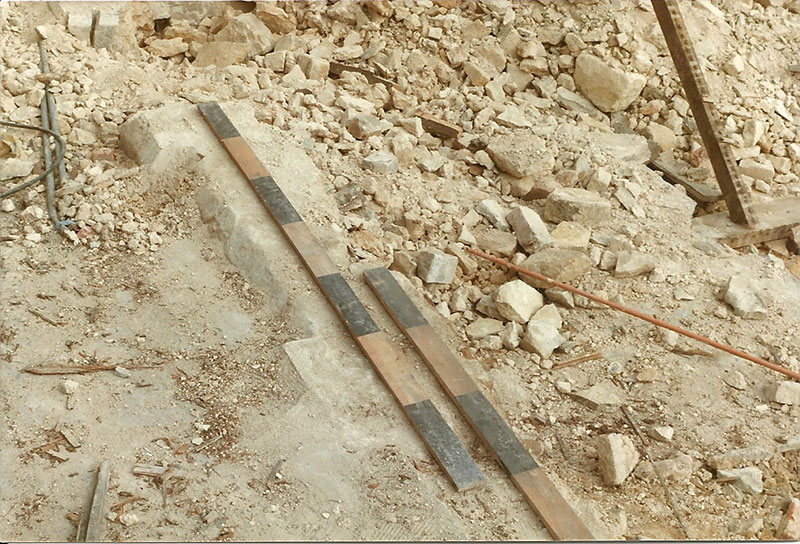
Original plinth stones at Heyford, being measured and photographed to allow for eventual replacement
Because the walls won’t be as thick or strong in terms of their continuous thickness, (you may remember that we needed to save weight because of the weak ground), there is a risk that the wind load on or under the platform canopy could break the walls, especially as winds seem to be getting stronger with climate change. To overcome this, the engineer has specified steels to sit within the walls. The canopy will be attached to the steels in places and the wind forces will be pushed down the steels rather than the walls. We have found it difficult to find a contractor willing to do this work at a fair price, but we have now found one and the steel has been ordered. We will erect it jointly.
At the moment the Tuesday gang is finishing off re-filling the space around the foundations with good quality infill – not too full as we need to get the services in first. This will need topping up when the plinth stones are in when we can lay the platform slabs so that the extended platform can be used. Of course public access will not be possible when we have scaffolding along the front of the building or when the canopy is being constructed so it may not be available very often!
The Thursday gang will shortly start working on getting the pipes in for the rainwater drainage, which will eventually run into soakaways. The pipes are on order for delivery next week.
Although we have devised a plan to deal with foul drainage utilising a small sewage treatment plant, we are re-visiting this to see if we can make a connection to a deep drain that runs across the site. This would overcome the difficulties inherent in removing sewage from a site with no road access. The only solution being the purchase of a sewage sludge pump and tank which would need to be taken off site by rail for emptying.
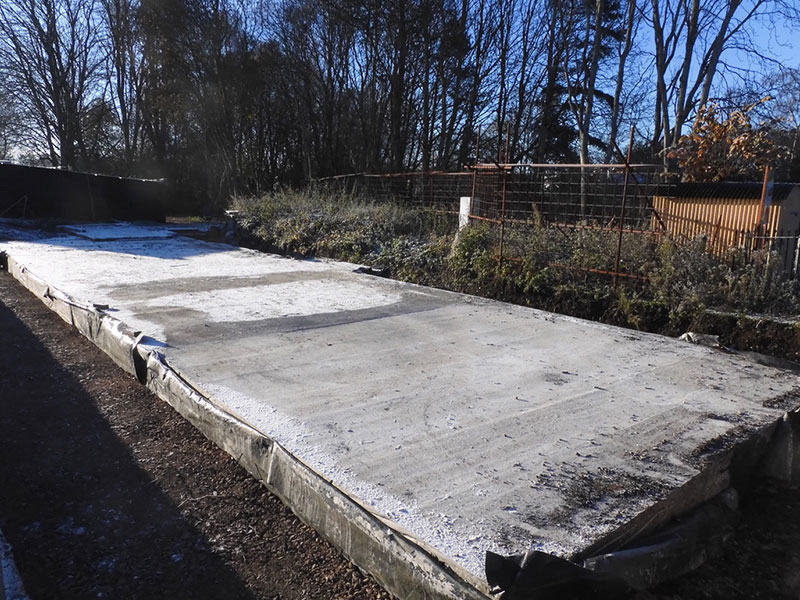
Finished concrete base with most of the shuttering removed, pictured in the winter sunshine - 15-Dec-2022
In the meantime, we have returned to fence maintenance and reconstruction, replacing a rotten baulk that formed the terminal post of the fence by the Heyford site access gate, which we nudged over with the road rail crane. We are taking the opportunity of replacing the intermediate posts too, so that the GWR concrete posts can be re-used elsewhere where more modern fencing is appropriate. See our February 2022 post for a reminder about the different types of fencing used by the GWR.
If you want to join us, we are almost always working on Thursday from about 10.00 to 16.00, but sometimes at other times at the weekend – get in touch with Tim Part via the Didcot office or by sending an e-mail to gws.heyford@outlook.com, if you are interested.
